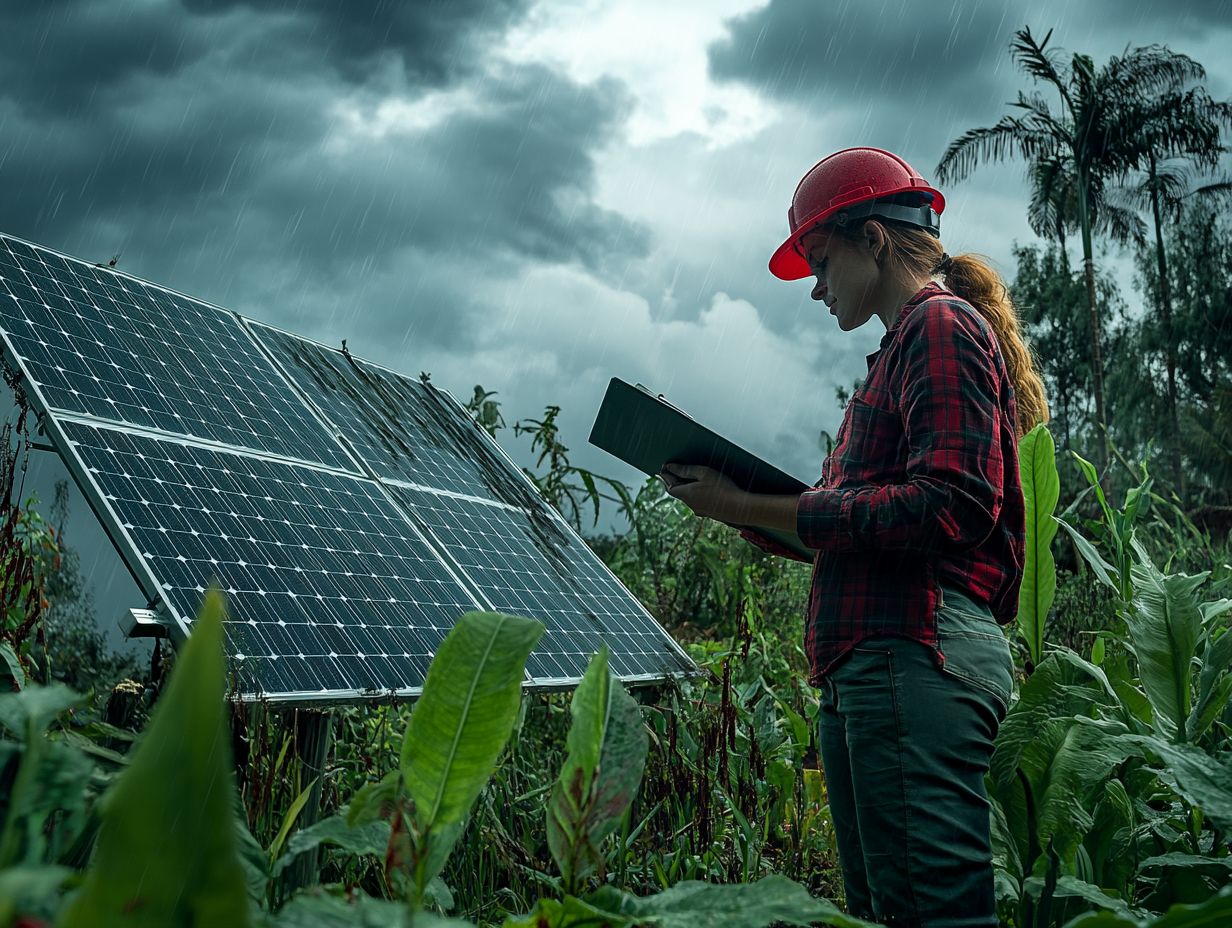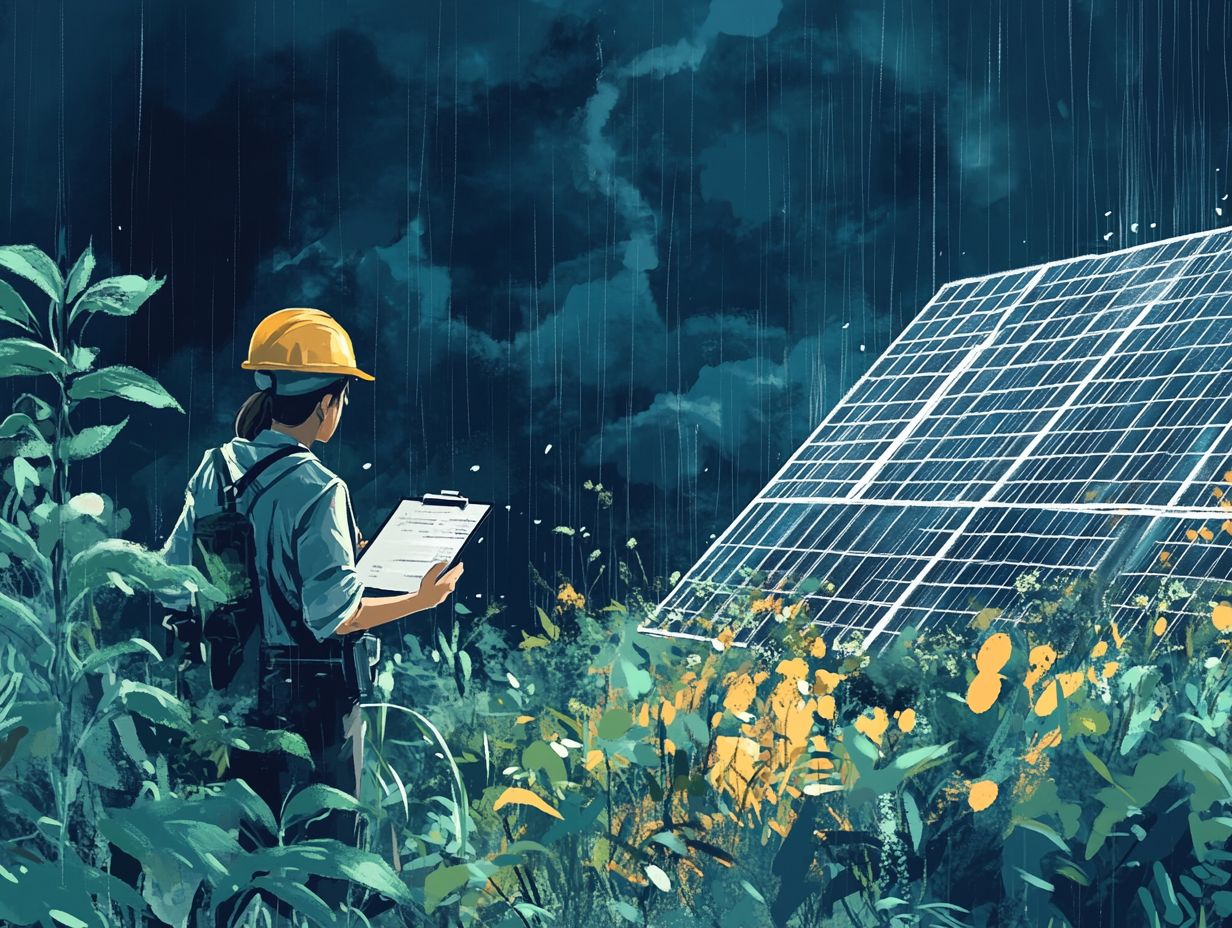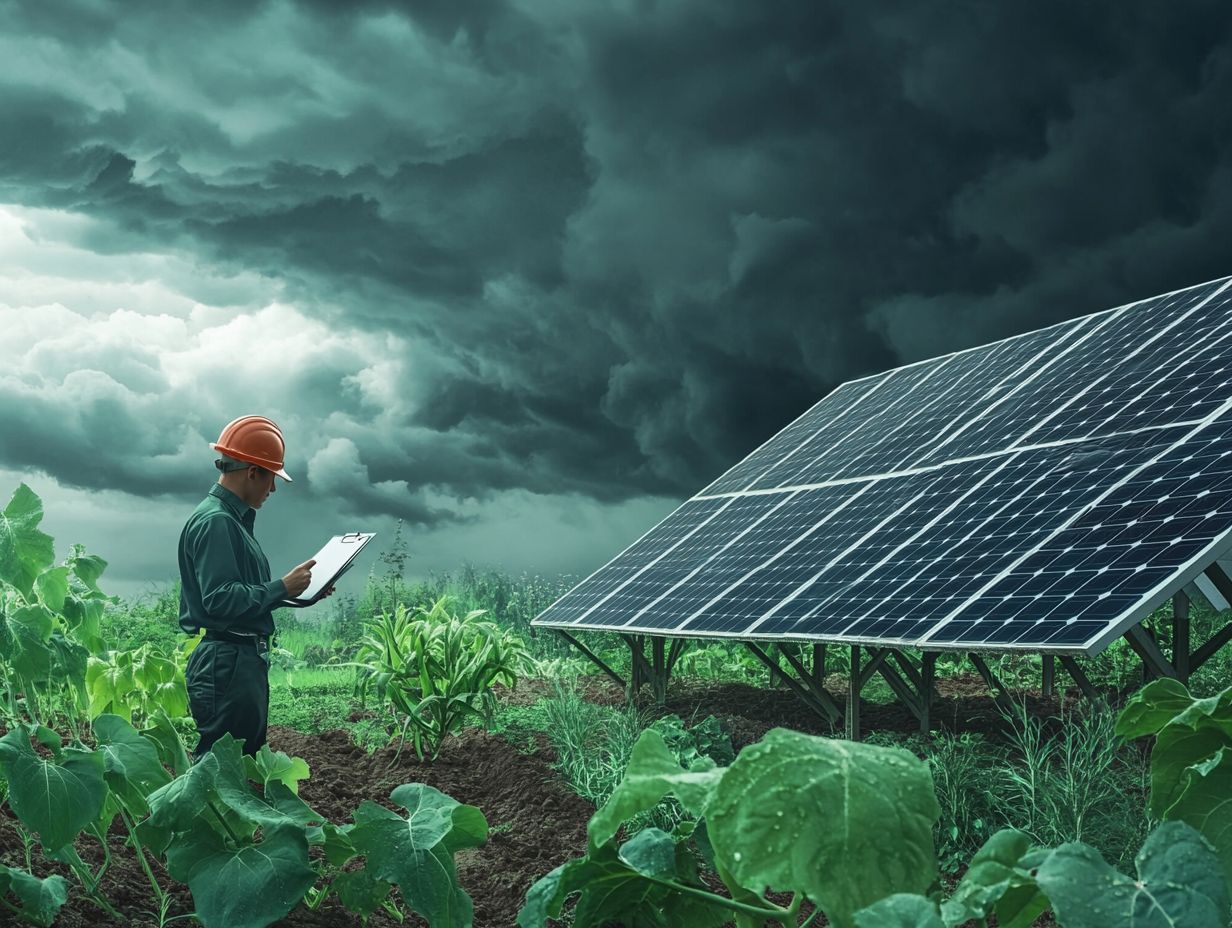Extreme weather and climate conditions can significantly impact solar systems, affecting both their performance and longevity.
As climate conditions become increasingly unpredictable, it is essential to understand how various weather elements influence solar energy systems and their role in sustainable energy. This article examines the durability and efficiency of different types of solar panels in harsh environments, discusses solar finance options, offers guidance on selecting the appropriate panels for specific weather conditions, and provides vital maintenance tips to ensure the solar setup operates optimally.
It is important for stakeholders to consider these factors, including storm-proof solar systems, to ensure that their solar investment can withstand the elements effectively.
Key Takeaways:

Understanding Extreme Weather and Solar Panels
Understanding the interaction between extreme weather and solar panels is crucial, particularly as climate conditions and climate change increasingly influence solar energy systems.
Weather events, ranging from cyclones in India to hailstorms in Australia, can significantly affect both the efficiency and durability of solar panels. This underscores the necessity for the development and adoption of storm-proof solar systems to ensure reliable energy generation.
How Different Weather Conditions Affect Solar Panels
Different weather conditions can significantly impact the performance and longevity of solar panels.
For example, while heavy rain may initially appear to hinder efficiency by blocking sunlight, it can actually benefit the panels by washing away dust and debris that accumulate over time. Conversely, high temperatures can reduce efficiency; as temperatures rise, solar panels often generate less electricity due to increased thermal resistance.
Additionally, storms and extreme weather events present risks such as debris impacts and flooding, which can compromise the structural integrity and operational capacity of the system.
It is essential for homeowners and businesses to understand these factors in order to maximize energy output, achieve energy independence, and ensure long-term reliability.
Factors to Consider When Choosing Solar Panels for Extreme Weather
When selecting solar panels for extreme weather conditions, it is essential to consider several critical factors to ensure optimal performance and longevity.
Durability and Resistance to Weather Elements

The durability and weather resistance of solar panels are essential factors in ensuring their longevity and consistent performance.
Enhanced materials are crucial in this context, particularly given the increasing frequency of extreme weather conditions. Impact-resistant glass, engineered to withstand hail and high winds, significantly minimizes the risk of damage that could impair functionality.
Additionally, the use of weather-resistant coatings and impact-resistant glass provides an extra layer of protection against harsh UV rays and heavy precipitation, ensuring that solar panels maintain optimal energy production even under adverse conditions.
This innovative approach not only protects the panels but also ensures that their performance remains reliable, even when faced with nature’s most challenging forces.
Efficiency in Low Light and High Temperature Environments
The efficiency of solar panels can vary significantly in low light and high-temperature environments, which impacts overall solar power generation and energy savings.
In such challenging conditions, bifacial solar panels designed to capture sunlight from both sides can outperform traditional panels by utilizing reflected light from surrounding surfaces. This capability enables them to generate additional energy, particularly in bright, reflective environments. While high temperatures generally degrade the performance of conventional solar cells, bifacial models tend to maintain better efficiency due to their innovative engineering.
Therefore, understanding these distinctions is crucial for optimizing solar energy production and maximizing yields for users, especially when considering efficiency and performance across varied climatic conditions.
Types of Solar Panels Suitable for Extreme Weather
Several types of solar panels are engineered to withstand extreme weather conditions, including monocrystalline, polycrystalline, and thin-film panels. Each of these options is designed with unique materials and structures that enhance durability and performance in challenging environments.
Monocrystalline, Polycrystalline, and Thin-Film Panels
Monocrystalline, polycrystalline, and thin-film panels each present distinct advantages and disadvantages regarding efficiency and performance under extreme weather conditions.
When evaluating these solar panel types, monocrystalline panels typically exhibit the highest efficiency rates, often exceeding 20%, making them particularly suitable for homeowners with limited roof space. Conversely, polycrystalline panels offer a more budget-friendly option but generally display slightly lower efficiency, which may necessitate a larger installation area.
Thin-film panels, on the other hand, stand out due to their flexibility and lightweight design, facilitating installation in unconventional locations. However, they generally underperform in terms of energy output and may encounter challenges in extreme weather conditions, necessitating careful consideration of their durability and maintenance in varying climates.
Tips for Maintaining Solar Panels in Extreme Weather

Maintaining solar panels in extreme weather conditions is crucial for ensuring optimal performance and extending the longevity of the solar energy system. Proper maintenance practices can significantly enhance the overall efficiency and durability of these systems, allowing them to operate effectively under varying environmental conditions.
Regular Cleaning and Maintenance Practices
Regular cleaning and maintenance practices are essential for preserving the performance of solar panels, particularly in extreme weather conditions. Accumulation of dust, debris, and grime on the surface can significantly reduce their efficiency. Implementing a quarterly cleaning schedule, especially following heavy rainfall or dust storms, is advisable to maintain optimal performance.
Utilizing soft brushes or squeegees along with gentle, environmentally-friendly cleaners can effectively remove build
up without causing damage. It is important for homeowners to monitor their panels routinely for signs of wear or potential issues, addressing these promptly to avoid costly repairs.
By prioritizing these maintenance tasks, homeowners can enhance the lifespan of their solar energy systems while minimizing their environmental impact, thereby maximizing the sustainable benefits of harnessing solar power.
Choosing the Right Solar Panels for Your Climate
Choosing the right solar panels for a specific climate is essential for maximizing energy savings, reducing your carbon footprint, and minimizing environmental impact.
Factors such as sunlight availability, temperature fluctuations, and potential weather patterns significantly influence the performance and efficiency of solar energy systems. For example, regions experiencing high temperatures may benefit from panels specifically designed to operate efficiently under such conditions, thereby enhancing energy output.
Conversely, areas that are prone to heavy rainfall or snow accumulation may require more durable options and robust solar modules that can withstand challenging weather.
Additionally, evaluating local shading from trees or buildings is crucial for determining the optimal placement of solar panels. This consideration ultimately leads to improved energy productivity and cost savings over time.
Frequently Asked Questions
What are the most important factors to consider when choosing solar panels for extreme weather?

When selecting solar panels for extreme weather conditions, it is crucial to consider factors such as durability, temperature tolerance, and wind resistance. These features will ensure that your panels can withstand harsh weather conditions and continue to produce energy efficiently.
How can I determine the durability of solar panels for extreme weather?
The durability of solar panels can be determined by their material composition and design. Panels made with high-quality materials such as tempered glass and corrosion-resistant frames are more likely to withstand extreme weather. It is also essential to look for panels with a high snow and wind load rating.
What is the ideal temperature tolerance for solar panels in extreme weather?
Solar panels with a high temperature tolerance are better suited for extreme weather conditions. Look for panels that can withstand both high and low temperatures, as extreme temperature fluctuations can affect the efficiency and lifespan of your panels.
Are there specific types of solar panels that are better for extreme weather?
Yes, certain types of solar panels, such as bifacial solar panels and those with impact-resistant glass, are better equipped to handle extreme weather conditions. For example, monocrystalline panels are known for their high temperature tolerance, while polycrystalline panels are more durable and can withstand hail and strong winds. Storm-proof solar systems with advanced sealing and corrosion-resistant mounting are also recommended. It is best to consult with a professional to determine the best type of panel for your specific location and weather conditions.
How can I ensure that my solar panels will be able to withstand extreme weather events?
Aside from selecting durable and weather-resistant solar panels, it is also essential to have them properly installed and maintained. Ensuring solar system certifications and wind load testing are part of your solar setup can increase resilience. Regular inspections and cleaning, along with following maintenance tips, can help identify any potential issues and ensure that your panels are in top condition to withstand extreme weather events.
Can I still use solar panels in areas prone to extreme weather?
Yes, solar panels can still be a viable energy solution in areas prone to extreme weather. By choosing the right type of panel, such as those with weather-resistant coatings, and ensuring proper installation and maintenance, solar panels can continue to produce energy and provide cost savings even in harsh weather conditions. Additionally, factors like solar finance options and government ratings can influence your decision. Investing in a robust solar power system can lead to energy independence and reduced carbon footprint.






